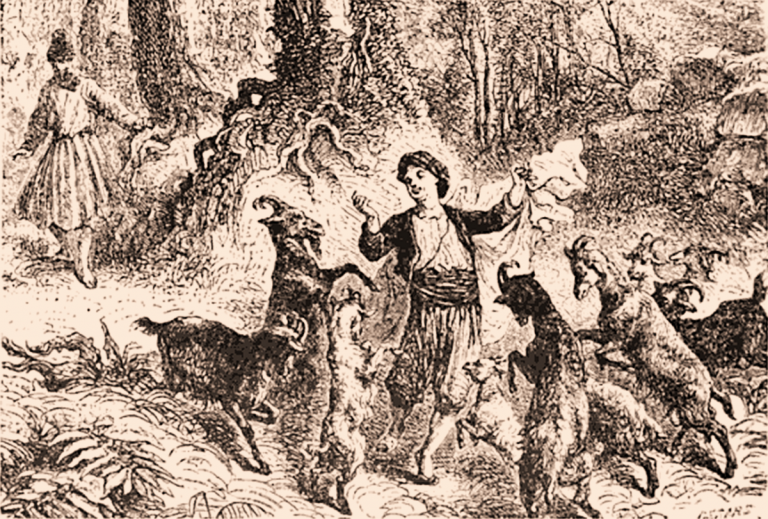It is believed that coffee was first discovered by a goat herder named Kaldi in Ethiopia. The story goes that Kaldi noticed his goats acting strangely after eating the berries from a certain bush. After trying the berries himself, he also felt an increase in energy and alertness.
Kaldi then took his findings to a local monk who was not interested in the berries. However, after seeing how Kaldi was able to stay awake during evening prayers, the monk had a change of heart and decided to try the berries for himself.
The rest, as they say, is history. Coffee is now enjoyed by people all over the world and has even become an important part of many cultures. In this blog post, we will take a closer look at the story of coffee and how it came to be such a beloved beverage.
Kaldi and his goats
Kaldi was a goatherder who lived in Ethiopia in the 9th century. One day, he noticed that his goats were acting strangely after eating the berries from a certain bush. They seemed to have more energy and were playful. Kaldi tried the berries himself and found that they had a similar effect on him. He felt more alert and awake.
Kaldi shared his discovery with the local monks, who were interested in finding ways to stay awake during their long hours of prayer. They made a drink from the berries and found that it helped them stay awake and focused. Word of this new drink spread, and coffee became popular all over the world.
Kaldi’s discovery
In Ethiopia, coffee was discovered by a goatherd named Kaldi. One day, Kaldi noticed that his goats were acting strangely after eating berries from a certain tree. They were so energetic that they couldn’t sleep at night! Kaldi tried the berries himself and found that he couldn’t sleep either.
Curious about this new discovery, Kaldi took some of the berries to a nearby monastery. The monks there told him that they had been using the berries to stay awake during their evening prayers. They also said that the coffee plant where the berries came from was sacred and should only be used for religious purposes.
Kaldi didn’t think much of the monks’ warnings and decided to continue experimenting with the coffee berries. He roasted them, ground them up, and boiled them in water to make a drinkable beverage. And just like that, coffee was born!
The coffee plant
The coffee plant is a small evergreen tree that grows in the forest understory. The coffee plant has dark green, glossy leaves and white flowers. The coffee plant produces berries, which are harvested and processed to make coffee.
The coffee plant is native to Ethiopia, where it was first discovered by a goatherd named Kaldi. Kaldi observed that his goats became more energetic after eating the berries of the coffee plant. Kaldi shared his discovery with the local monks, who began to brew a drink from the berries to keep themselves awake during prayer. word of the energizing drink spread, and coffee became popular around the world.
How coffee is made
Coffee beans are actually the pits of coffee berries. So, how is coffee made?
First, the coffee cherries are harvested by hand and sorted. Then, the beans are extracted from the fruit and cleaned.
The next step is to roast the beans to bring out their flavor. Roasting also determines the level of caffeine in the final product.
After roasting, the beans are ground and brewed with hot water to create coffee. Different brewing methods will produce different results.
The benefits of coffee
In the 9th century, an Ethiopian goatherder named Kaldi discovered coffee when he noticed that his goats became more energetic after eating coffee berries. Kaldi shared his discovery with the local monastery, and the monks began to make a drink with the coffee berries and found that it kept them awake during their evening prayers. news of this “miracle drug” spread and coffee plantations began to crop up in countries all around the Arabian Peninsula.
Coffee became popular because of its many benefits. For one, it was a much safer alternative to alcohol which was often consumed in excess by medieval Europeans. Coffee also helped people stay awake and alert, making it ideal for students studying for exams or workers pulling all-nighters. In addition, coffee was believed to have medicinal properties and was used to treat a variety of ailments such as headaches, gout, and even scurvy.
Today, we continue to enjoy coffee for its taste and energizing effects. And thanks to Kaldi’s discovery all those centuries ago, we have this delicious beverage to help us power through our days!
The history of coffee
The coffee plant, Coffea Arabica, is native to Ethiopia. The story of how coffee was discovered is often told through the legend of Kaldi, an Ethiopian goatherd.
The story goes that Kaldi noticed his goats acting strangely after eating the berries from a certain plant. After trying the berries himself, Kaldi felt an uplifting energy and shared his discovery with the local monastery. The monks were skeptical at first, but after trying the berries themselves they found that it helped them stay awake during their long hours of prayer.
Word of the energizing effect of the coffee berries spread, and soon people were coming from all over to try this new “miracle drug”. Coffee quickly became a staple in Ethiopian culture, and from there its popularity spread to the Middle East, Europe, and eventually the Americas.
Today, coffee is one of the most popular beverages in the world. It’s estimated that over 500 billion cups of coffee are consumed each year!
Conclusion
So the next time you’re enjoying a cup of coffee, remember the story of Kaldi and his goats. And if you’re ever in Ethiopia, be sure to visit one of the many coffee ceremonies that take place daily. They are a wonderful way to experience the culture and tradition of this amazing country.
Source: This article’s feature image link: https://dreambeanscoffee.ie/history-of-coffee-kaldi-the-goatherd/




